
|
Crawdad
Family Astacidae
First posted August 1, 2004 Last
updated October 21, 2004
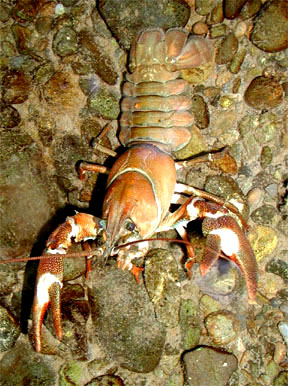
A crawdad at Caz in a defensive posture
Photo by David Nelson, specimen from
Austin Creek, July 23, 2004

The crawdad,
also know as the crawfish, mud
brother, and by many other names, is a constant
hit with the campers at Caz: they are easy to catch
and fun to play with. A common classroom biology subject,
it is also the only animal at camp that is commonly
eaten. And not just in the French Quarter in New Orleans:
it has a world-wide distribution and is eaten in many
countries. Crawfish feed on dead animals as well as
live pollywogs, small fish, and most anything that they
can catch. They are decapods, which means that they
have 10 legs.

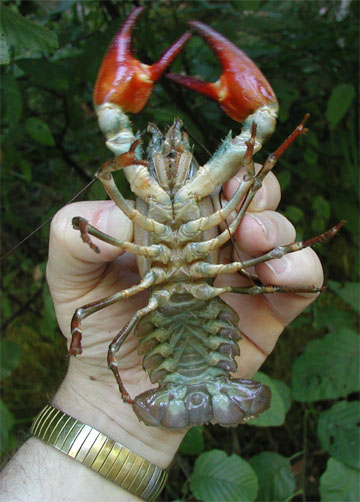
The underside reveals the (from front
to rear) the mouthparts, 10 legs, swimmerets under the
tail
Photo by David Nelson, specimen from
Austin Creek, July 23, 2004
Crawfish Structure
The crayfish is typical of most shrimplike
crustaceans and is characterised by a joined head and
thorax, or midsection, and a segmented body, which in
the species at camp is a reddish brown, although the
larger ones have white markings around the base of the
main claw, or chelipeds.
The crayfish are usually seen are about 3 inches to
6 inches long, but if you look among the smaller rocks
you can find miniatures under 1 inch, or monsters greater
than 6 inches in the larger pools. There are about 150
species in North America, and there are more than 500
throughout the world. Among the smallest is the 1inch
long Cambarellus diminutus
of the south-eastern United States, and among the largest
is Astacopsis gouldi of Tasmania.
It can grow to reach 16 inches and its weight is about
8 pounds.
The crawfish is an excellent example of body segmentation,
a theme seen throughout the animal kingdom. The head
has three pairs of sensory antennae (two pair are very
small and usually overlooked; see the photographs below)
and a pair of eyes on movable stalks. The "legs",
or more properly, appendages,
or pereiopods, all attach
to the thorax. As noted above, there are 10 legs. Note
that the animal is bilaterally symmetric,
which means its right side and its left side are the
same. This is another theme seen throughout almost all
of the animal kingdom. The 10 legs, therefore, are organized
as five pairs of legs. The first pair are the large
claws, called chelipeds. Watch
a crawdad at the bottom of a pool at Caz and you can
see that the crawdad extends in front of its body while
moving. These strong pinchers are specialised for cutting,
capturing food, attack, and defence. A pinch can hurt!
The next two pair of legs each have miniature claws
and are used for feeding as well as walking. Watch a
crawdad in a pool and you will see it pick up food with
the large claws and then pass it to these smaller claws,
then to its mouthparts. When you pick one up, be careful
these don't nip you! They are not powerful enough to
hurt, just tickle. The rear two pair of legs end in
points, not claws, and are used only for walking. The
large muscular abdomen is attached to the tail, which
is used in short bursts to escape enemies, which include
raccoons (and campers!). The crayfish also has five
pairs of swimmerets which
are under the abdomen. All of these "legs"
can be regenerated if broken off.
Crayfish have a shell, or carapace,
which is its outside skeleton, or exoskeleton.
This jointed shell provides protection and allows movement,
but limits growth. As a result, the crayfish regularly
gets too big for its skeleton, sheds it, and grows a
new larger one. (See below for a great science activity
that you can do with the shed shell.) This is called
molting, and occurs six to ten times during the first
year of rapid growth, but less often during the second
year. For a few days following each molt, crayfish have
soft exoskeletons and are more vulnerable to predators.
|
|
|
You have a skeleton on the
inside, called an endoskeleton.
These bones help you to move and protect your
brain, heart, lungs, and other soft parts. |
|
The crawfish has its skeleton
on the outside, called a shell or an exoskeleton.
This shell does the same things as your skeleton:
helps it move and protects is brain, heart,
and other soft parts. |
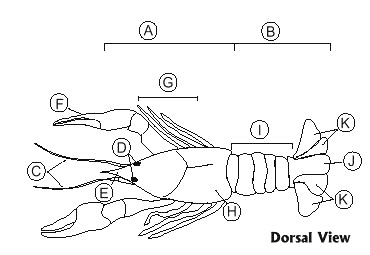
This is a diagram of a crawdad, from
the top, or dorsal, side. A is the
cephalothorax and B is the tail.
C marks the second antennae; not
shown are the two pair of first antennae. D
indicates the eyes, E is the rostrum,
a projection out over the eyes. F
refers to the main claws, called the chelipeds, specialized
for fighting, defending, and holding onto food. G
shows the peripods, or walking legs. They also are
used in feeding and probing crevices for food. The
front two pairs have claws, the back two pairs are
pointed and clawless. H is the carapace,
or shell over the cephalothorax, that protects the
internal organs. J is the uropod,
or center part of the tail, and K
marks the telsons, or lateral parts of the tail. Swimmerets,
not shown, are on the underside of the tail, I.
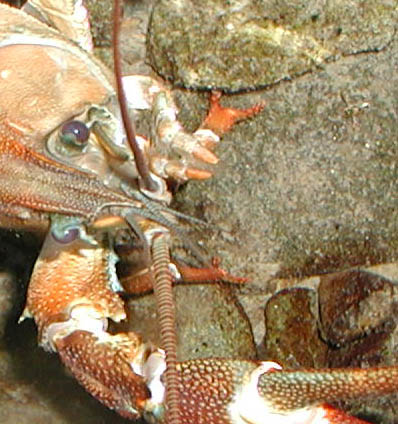 |
 |
Here you can
see the two pair of first antennae
that are not shown in the diagram above.
They originate from just above
and between the secondary antennae.
Photo by David Nelson, specimen from Austin
Creek, July 23, 2004 |
It is fun to try to catch a crawfish,
place them in a shallow container and watch them crawl
around. Try to draw one and you will find youself
"seeing" more than you did before!

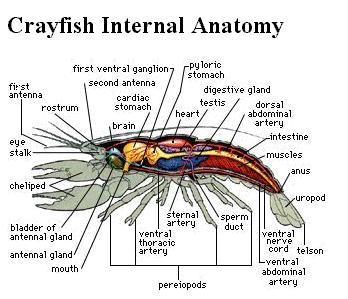

Crayfish Behaviour
Crayfish often conceal themselves under
rocks or logs. They are most active at night, when
they feed largely on snails, algae, moss and other
vegetation, insect larvae, worms, fish, tadpoles,
almost any kind of dead animal matter, old shed carapaces
(crawdad shells), and even other crawfish. Studies
show that adults (one year old) become most active
at dusk and continue heavy feeding activity until
daybreak. Young crayfish are more likely to be the
ones out during bright sunny days, while the older
crayfish are more active on cloudy days and during
the night. Although they mainly feed in the water,
they do venture out a little onto land, but they are
vulnerable to predation and breathe by gills, so terrestrial
activity is limited. Terrestrial activity allows them
to escape from isolated pools when the creek dries
up. General movement is always a slow walk. If you
sit quietly on a rock, you can see them walk about
the bottom, feeding and fighting, holding their large
claws out in front. Small crawfish will always back
away from a larger one. If startled, crayfish use
rapid flips of their tail to swim backwards and escape
danger.
Most crayfish live short lives, usually
less than two years. Therefore, rapid, high-volume
reproduction is important for the continuation of
the species. Many crayfish become sexually mature
and mate in the October or November after they're
born, but fertilisation and egg laying usually occur
the following spring. The fertilised eggs are attached
to the female' swimmerets on the underside of her
jointed abdomen. There the 10 to 800 eggs change from
dark to translucent as they develop. The egg-carrying
female is said to be ‘in berry,’ because
the egg mass looks something like a berry. Females
are often seen "in berry" during May or
June. The eggs hatch in 2 to 20 weeks, depending on
water temperature. The newly-hatched crayfish stay
attached to their mother until shortly after their
second molt. If you want to find baby crawfish, look
in the small stones and gravel along the edges of
the pools of Austin Creek.

Crayfish as
Food
Most people know that crayfish are good
to eat. In some places in the US, such as Louisiana,
crayfish are a specialty and are served up boiled
in spices, baked, fried, or served with noodles, rice,
etc. Crawfish etouffee is a famous dish in New Orleans!
It is delicious! Here is a recipe from Nurse
Di who grew up in Louisiana:
2 tablespoons flour
2 tablespoons vegetable oil
3 cans chicken broth
1 medium bell pepper, chopped
2 medium onions, choped
3 celery ribs, chopped
1 can cream of mushroom soup
1 (15 ounces) can tomato sauce
1 tablespoon parsley flakes
1 teaspoon Accent seasoning
3 cloves garlic, minced
1 teaspoon salt
1/2 teaspoon pepper
1/4 teaspoon basil
1/4 teaspoon poultry seasoning
1 teaspoon Worcestershire sauce
1 teaspoon lemon juice
2 lbs crawfish tails
1/2 cup chopped green onions
hot cooked rice

| SCIENTIFIC
CLASSIFICATION
Crawdad
CLASS: Arthopoda
ORDER: Crustacea
SUBORDER: Decapoda
FAMILY: Astacodae
SUBFAMILY:
GENUS & SPECIES: |
Scientific Classification
Crayfish are part of the order Decapoda
constituting the families Astacidae (Northern Hemisphere),
Parastacidae, or Austroastracidae (Southern Hemisphere).
The most common genera of North America include Procambarus,
Orconectes, Faxonella, Cambarus, Cambarellus, and
Pacifastacus. Austropotamobius is the most common
genus of Europe. The genus Astacus occurs in Europe,
the genus Cambaroides in East Asia. The arthopod class
also includes centipedes, crustaceans, insects, millipedes,
mites, scorpions and spiders.

Fun Science
Activity
Crawdads shed their skin, called the
exoskeleton, as they grow. This gives
rise to a great activity: mounting the shed shell.
These can be gathered from the streambottom. Place
them in a plastic bag to keep them moist. Clean the
shell off in fresh water then lay it out on a piece
of cardboard. If you position the antennae, claws,
tail, and legs in a realistic position, it will harden
in a day or two (see photo). You can reposition any
part later by moistening the joints then re-drying.
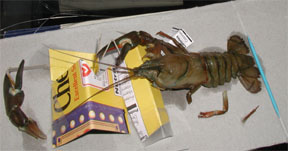
Shell being positioned for drying
Photograph by David Nelson, July 26,
2004
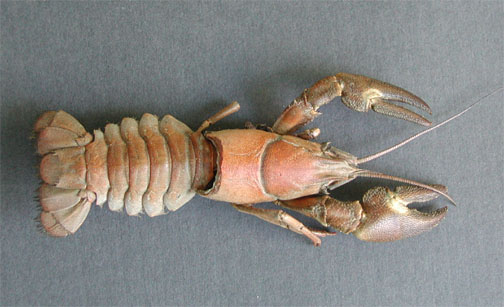
A finished exoskeleton

References
The Brigham
Young University website is full of scientific
information.
Acknowledgements
The crawdad diagram is from the Louisian
Marine Education Resources website.
The description of the structure, behaviour, internal
anatomy, and science is taken or adapted from the Crayfish
Corner.

|

|

